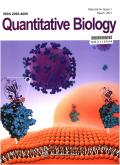Reorganizing heterogeneous information from host–microbe interaction reveals innate associations among samples
IF 1.4
4区 生物学
Q4 MATHEMATICAL & COMPUTATIONAL BIOLOGY
引用次数: 0
Abstract
The information on host–microbe interactions contained in the operational taxonomic unit (OTU) abundance table can serve as a clue to understanding the biological traits of OTUs and samples. Some studies have inferred the taxonomies or functions of OTUs by constructing co‐occurrence networks, but co‐occurrence networks can only encompass a small fraction of all OTUs due to the high sparsity of the OTU table. There is a lack of studies that intensively explore and use the information on sample‐OTU interactions. This study constructed a sample‐OTU heterogeneous information network and represented the nodes in the network through the heterogeneous graph embedding method to form the OTU space and sample space. Taking advantage of the represented OTU and sample vectors combined with the original OTU abundance information, an Integrated Model of Embedded Taxonomies and Abundance (IMETA) was proposed for predicting sample attributes, such as phenotypes and individual diet habits. Both the OTU space and sample space contain reasonable biological or medical semantic information, and the IMETA using embedded OTU and sample vectors can have stable and good performance in the sample classification tasks. This suggests that the embedding representation based on the sample‐OTU heterogeneous information network can provide more useful information for understanding microbiome samples. This study conducted quantified representations of the biological characteristics within the OTUs and samples, which is a good attempt to increase the utilization rate of information in the OTU abundance table, and it promotes a deeper understanding of the underlying knowledge of human microbiome.重组来自宿主-微生物相互作用的异质信息,揭示样本间的先天联系
操作分类单元(OTU)丰度表中包含的宿主与微生物相互作用的信息可以作为了解OTU和样本生物特征的线索。一些研究通过构建共现网络来推断OTU的分类学或功能,但由于OTU表的高度稀疏性,共现网络只能涵盖所有OTU中的一小部分。目前还缺乏深入探索和利用样本-OTU 相互作用信息的研究。本研究构建了一个样本-OTU异质信息网络,并通过异质图嵌入方法表示网络中的节点,形成OTU空间和样本空间。利用所表示的OTU和样本矢量与原始OTU丰度信息相结合的优势,提出了嵌入式分类和丰度综合模型(IMETA),用于预测表型和个体饮食习惯等样本属性。OTU空间和样本空间都包含合理的生物或医学语义信息,使用嵌入式OTU和样本向量的IMETA在样本分类任务中具有稳定和良好的性能。这表明,基于样本-OTU 异构信息网络的嵌入表示能为理解微生物组样本提供更有用的信息。本研究对OTU和样本内部的生物学特征进行了量化表示,是提高OTU丰度表信息利用率的一次有益尝试,促进了对人类微生物组底层知识的深入理解。
本文章由计算机程序翻译,如有差异,请以英文原文为准。
求助全文
约1分钟内获得全文
求助全文
来源期刊

Quantitative Biology
MATHEMATICAL & COMPUTATIONAL BIOLOGY-
CiteScore
5.00
自引率
3.20%
发文量
264
期刊介绍:
Quantitative Biology is an interdisciplinary journal that focuses on original research that uses quantitative approaches and technologies to analyze and integrate biological systems, construct and model engineered life systems, and gain a deeper understanding of the life sciences. It aims to provide a platform for not only the analysis but also the integration and construction of biological systems. It is a quarterly journal seeking to provide an inter- and multi-disciplinary forum for a broad blend of peer-reviewed academic papers in order to promote rapid communication and exchange between scientists in the East and the West. The content of Quantitative Biology will mainly focus on the two broad and related areas: ·bioinformatics and computational biology, which focuses on dealing with information technologies and computational methodologies that can efficiently and accurately manipulate –omics data and transform molecular information into biological knowledge. ·systems and synthetic biology, which focuses on complex interactions in biological systems and the emergent functional properties, and on the design and construction of new biological functions and systems. Its goal is to reflect the significant advances made in quantitatively investigating and modeling both natural and engineered life systems at the molecular and higher levels. The journal particularly encourages original papers that link novel theory with cutting-edge experiments, especially in the newly emerging and multi-disciplinary areas of research. The journal also welcomes high-quality reviews and perspective articles.
 求助内容:
求助内容: 应助结果提醒方式:
应助结果提醒方式:


